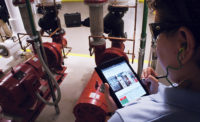OSHA-mandated lockout-tagout (LOTO) practices began in 1989 with the introduction of regulation CFR1910.147. The agency estimated hundreds of fatalities every year could be prevented’
OSHA was right. Fatalities due to LOTO (or lack thereof) fell dramatically, but then something else happened—the fatality statistics leveled off and plateaued. And not just the fatalities, but amputations and severe fines for companies not complying with this multi-decade old law.
Lockout-tagout—the control of hazardous energy as OSHA calls it—ranks as the No. 1 most-cited regulation for manufacturers and sits on the top 10 most-cited regulations for all industries. And it appears the volume of violations will continue. OSHA violation totals went up more than 50 percent compared to the prior year and the trend is increasing. When asked, an OSHA representative says, “We’re not negotiating as much as we used to on these citations. The message should now be clear—comply or pay.”
Companies are fed up too. If they actually complied and did what OSHA is asking, they would go out of business (so they say). If they don’t comply, they risk major fines that could be a death blow to small and medium size businesses.
So what’s the answer? Alternative Protective Measures—APMs as they are referred to in the industry. They are the secret weapon against excessive downtime caused from using LOTO as the main tool for rendering equipment safe for service.
What are APMs?
APMs are documented procedures that show how to control a piece of equipment in a way that is “as effectively as safe as LOTO for a particular task.” These are fighting words for most OSHA inspectors, but trust me, it’s not only allowed, it’s written in black and white in the federal regulation.
OSHA’s LOTO regulation writers did not make the standard prescriptive; they made it directional. In order to comply, you must establish certain elements (procedures, training, policy, auditing & devices) in a way that keeps people safe while servicing the equipment. A lockout-tagout procedure’s job is to identify all energy sources that could pose a hazard a person while servicing and show how to follow sequential steps to render these sources neutralized and controlled from unexpected re-connection.
There’s nothing wrong with the effectiveness of a lockout-tagout procedure—for certain uses. In fact, nothing beats LOTO when it comes to major maintenance that can be done when the machine is fully disconnected from its energy sources. The problem comes in when you need a machine to be partially live in order to perform your service—that’s when APM comes in.
There are two main reasons APMs should exist in every facility—regardless of the perspective the safety and plant manager has about lockout-tagout usage. The first: there are certain times when equipment needs to be serviced partially live for diagnostic work or programming. Lockout-tagout would not just impractical, it would be impossible. But OSHA doesn’t care about this issue—if someone gets hurt servicing this equipment and lockout-tagout was not properly used, then you’ll get cited for lockout-tagout (not APM).
The second reason APMs are needed is because there are instances when LOTO could be used, but it’s largely inconvenient or impractical.
What does an APM consist of?
APMs—when engineered correctly—shall have multiple methods for controlling the equipment. Think redundancy. If e-stops, key offs, or electrical door interlocks are used, make sure you have a way to test the affirmation that the APM worked built into each task group.
APMs should be zone specific—not just machine-specific like lockout-tagout. You don’t want an authorized user to enter a machine following an APM only to expand the service outside the intended scope of the APM.
APMs should be task-specific as well to keep authorized users focused on only the tasks the APM was designed for.
The APM program should mesh with your LOTO program so the authorized employees understand the rules, techniques and limitations of each program. All the same elements should exist for your APM program as in your lockout-tagout program. Those elements are:
• Graphical APM Procedures that show the machine serviceable zone, the tasks, the PPE, the tools, and the verification steps necessary to establish a machine state that is as effective as LOTO.
• Auditing routine that checks the APMs at least annually to verify the equipment is still the same and the APMs will provide effective protection.
• Corporate policy that shows the rules, responsibilities and ways to correct any identified deficiencies in the program over time.
• Training for the employees who will use the APM procedures. Since this isn’t lockout-tagout, you could train operators to use APMs and call them APM authorized, but they don’t have to be fully trained as an authorized employee unless they apply locks and will use lockout-tagout. The training should include nearly all the same elements of a lockout-tagout training including the hazards of working around the sources of energy they will be near.
• Devices, locks and tags that are specifically meant for an APM program.
While implementing an APM program might be a daunting task for some companies, it’s well worth it for just about any manufacturing company and just about any other industry where LOTO might be nearly impossible to use and severely impacts the bottom line. In fact, the cost to outsource the program should pay for itself three times or more in the first year depending on the environment. When the ROI is considered, there should be no excuse to start learning more now about how the next big safety investment for your company includes APM elements.
Disclaimer: While it may be possible to engineer out many servicing activities with well-engineered safety procedures and high performance hardware, Rockwell Automation always recommends users follow lockout-tagout regulations when performing service on equipment where no “company approved” safe alternatives exist. Finally, users shall assure themselves that all maintenance and servicing procedures are safe, effective, and properly tested according to good practice and regulation.

